Spain is buying another 25 Eurofighter Typhoons, to replace some of its oldest EF-18 Hornet fighters, as part of a continuing modernization program for the Spanish Air and Space Force. The announcement of the deal comes amid something of an upturn in fortunes for the pan-European multirole fighter, which is also receiving new radars and weapons.

Known as the Halcón II (Hawk II) program, the latest Spanish contract, which covers 21 single-seat and four twin-seat Typhoons, was announced today. The agreement was signed between the Spanish government and the NATO Eurofighter and Tornado Management Agency (NETMA), based in Germany. Deliveries are due to start in 2030.
Back in 2022, Spain had ordered another batch of 20 Typhoons, under the Halcón I program, a plan that you can read more about here. These jets will start to be delivered in 2026.
A photograph published on social media today showing the first Halcón I Typhoon in production in Spain:
Between them, Halcón I and II bring total Spanish orders for the Typhoon to 118 aircraft. Initially, Spain signed up for 73 Typhoons, although three have been lost through attrition, leaving a current fleet of 70 aircraft from Tranche 1, 2, and 3A production.
Like the earlier jets, the Halcón I and II Typhoons will be built locally at the Airbus plant in Getafe, near Madrid.
Typhoons delivered under Halcón I and II will be considerably more capable than the Tranche 1, 2, and 3A aircraft already in service.

The new Tranche 4 standard features advanced avionics, including an active electronically scanned array (AESA) radar. For the Spanish aircraft, this radar is the Captor-E Mk 1, which you can read more about here.

Tranche 4 also has enhanced weapon systems allowing it to use the Brimstone 3 precision air-to-ground munition and full capability with the Meteor beyond-visual-range air-to-air missile.
Today, the Spanish Air and Space Force — or Ejército del Aire y del Espacio — fields Typhoons at the air bases of Morón (11th Wing), near Seville, and Los Llanos (14th Wing), in Albacete.
An official video showing Typhoons from Morón (11th Wing) and Los Llanos (14th Wing):

Next, the service will introduce Typhoons at Gando (46th Wing), in the Canary Islands, as it starts the process of replacing its oldest EF-18 ‘legacy’ Hornets. The Canary Islands are a Spanish archipelago located in the Atlantic Ocean, west of Morocco.
These oldest Hornets were previously operated by the U.S. Navy and U.S. Marine Corps as F/A-18As. A total of 24 were sourced from U.S. stocks between 1995 and 2000 and were modernized to the F/A-18A+ standard, making them broadly comparable with the U.S. Navy’s F/A-18C/D. However, the airframes are now old and, although they have a multirole capability, they have always been primarily used for air defense.
While the Halcón I Typhoons will succeed the old EF-18s in the Canary Islands, Halcón II will kickstart the replacement of the remaining Spanish Hornets.

These were delivered new, from the aircraft’s original manufacturer, McDonnell Douglas, between 1986 and 1992. A total of 72 were received, but the fleet has since been reduced to 52 single-seaters and 12 two-seaters.
Spain’s new-build Hornets were put through an upgrade program in the mid-1990s, which brought them up to a standard that was broadly similar to the F/A-18C/D. The resulting aircraft, which became known as EF-18A+/B+s, featured new mission computers, targeting pods, and AIM-120 AMRAAM capability.
A continued process of enhancements under a mid-life upgrade effort has since helped the Hornets keep pace with their rivals, adding the Thales Scorpion helmet-mounted display and a ROVER air-to-ground video datalink for the targeting pod, among others. In the process, the jets received the revised designations EF-18AM/BM.

While not as worn-out as the ex-U.S. EF-18s serving in the Canary Islands, these aircraft are also now showing their age. It’s notable, meanwhile, that the equivalent F/A-18C/D has now been retired from frontline U.S. Navy service.
Back in 2020, The War Zone suggested that Spain might well buy more Typhoons (today’s Halcón II announcement), but a question remains about its plans for the rest of the EF-18 fleet, which will also require replacement before too long.
As an alternative to more Typhoons, Spain might choose to risk waiting on the new pan-European combat jet being developed under the Future Combat Air System (FCAS), which also involves France, Germany, and Belgium. The FCAS initiative plans to field a sixth-generation stealthy crewed fighter and accompanying uncrewed platforms, weapons, and sensors by 2040.

Whether the FCAS program meets this timeline is questionable, however, and this might lead to more Spanish orders for Typhoons. Having bought batches of 20 and 25 Tranche 4 Typhoons, another batch of 20-25 aircraft might be an option, depending on FCAS progress.
At the same time, there is a Spanish Navy requirement to replace its EAV-8B+ Matador II short takeoff and vertical landing (STOVL) jets — equivalent to the U.S. Marine Corps AV-8B+ Harrier II — which operate from the deck of the amphibious assault ship Juan Carlos I. Here, the only crewed fighter option is the F-35B Joint Strike Fighter.

With a force of only 13 Matador IIs to replace from around 2030 to 2034, buying F-35Bs for just this requirement will likely prove cost-prohibitive. However, there may be an argument to buy a larger force of F-35Bs to operate from the Juan Carlos I and from land bases, paralleling the arrangement adopted by the United Kingdom.
Whatever happens with replacing the Matador II and the remaining EF-18s, today’s announcement only reinforces Spain’s commitment to the Typhoon.
In contrast to other operators, most of which are planning to withdraw their oldest Tranche 1 Typhoons, Spain decided to upgrade its 17 surviving Tranche 1 jets. Airbus has incorporated later Tranche 2 and Tranche 3 equipment in these aircraft, to provide a full multirole capability. Re-deliveries of the modernized Typhoons began in 2019.
Outside of Spain, Eurofighter has secured follow-on orders from other core customers.
Germany is buying 38 Tranche 4 aircraft and another 20 Tranche 4+/5 jets, 15 of which will be configured for electronic warfare missions. Italy is also adding to its fleet, with an order for 24 Tranche 4 aircraft.

In terms of capabilities, the Typhoon is also advancing.
The Captor-E Mk 2 radar, also known as ECRS Mk 2 radar, has now been fitted in a British Typhoon. This is an even more advanced radar than the ECRS Mk 1 that Spain will receive and includes a unique ‘swashplate’ positioning mechanism to further boost its capabilities.
A recent photo published by the Hensoldt company in Germany — part of the ECRS consortium — indicates that inflight tests of the ECRS Mk 1 are also due to start soon. In this case, rather than mounting the radar in a Typhoon, it has been installed in an Airbus A320 flying testbed, within a radome grafted onto the front of the airliner.

In other Typhoon news from today, Germany has decided to complete the work to integrate the Taurus KEPD 350 cruise missile on the aircraft. Germany originally acquired this weapon to arm its Tornado IDS swing-wing strike aircraft and, although trials have been carried out with the Typhoon, it was not fully integrated. Now, the Taurus KEPD 350 will be introduced on operational German Typhoons, as part of the P4E upgrade package. That should see the German Air Force deploying the cruise missile on its Typhoons from 2028 or 2029. As a Taurus KEPD 350 operator, Spain might also choose to integrate the missile on its Typhoons, too.
Yesterday, meanwhile, the four Eurofighter partner nations — Germany, Italy, Spain, and the United Kingdom — signed a contract that will pave the way for more future upgrades for the Typhoon.
The Long-Term Evolution (LTE) program, which has now entered the technology maturation phase, will focus on the aircraft’s avionics architecture. The work will include developing a new cockpit featuring a large-area display, as well as new flight-control and mission computers, communications equipment, and armament control systems.
For some time, interest in the Typhoon seemed to have stalled, with the rival French Dassault Rafale emerging to secure a string of lucrative orders.
Now, however, the partner nations’ commitment to the Typhoon — both in terms of upgrades to existing aircraft and additional orders for new Tranches — is providing Eurofighter with a major boost. Demonstrations of support from the core customers could well also help drive export interest. Eurofighter now speaks confidently about the Typhoon remaining in frontline service until 2060.
Earlier this year, Eurofighter said that it was eyeing potential sales to Qatar (a second batch of 12 jets) and Saudi Arabia (a long-awaited order for 54 more jets). Meanwhile, in NATO, the company has been eyeing potential sales to Turkey (40 aircraft) and Poland (32 aircraft).
Regardless, Spain’s order for another 25 Typhoons is good news for Eurofighter as it seeks to keep the aircraft at the forefront of European air combat at least until the arrival of sixth-generation crewed fighters — and likely long beyond that, too.
Contact the author: thomas@thewarzone.com
